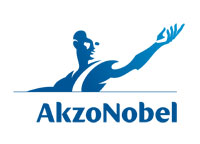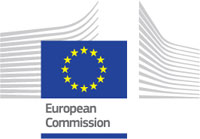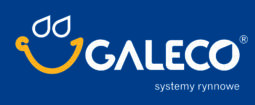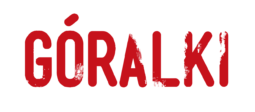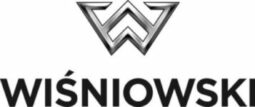Consumer behaviour
research
Table
of contents
- What is consumer behaviour?
- What is consumer behaviour research about?
- Why is consumer behaviour research so important?
- What kind of information does consumer behaviour research deliver?
- What are consumer behaviour trends?
- What factors influence consumer behaviour?
- What is consumer percpection?
- Which techniques do we apply in consumer behaviour research?
- Our Clients
- Why choose our offer?
- Consumer behaviour research – Price list
- FAQ
Consumer behaviour involves habits, actions and decisions which are made or take place while searching, ordering and buying products and services. For many years, attempts were made to explain consumer behaviour by referring to classical economic concepts. It was assumed that people make rational choices, calculating their potential gains and losses.

From this point of view, consumer choices are explained mainly by marketing and economic factors, such as product characteristics, price and distribution, however, consumer’s financial resources where deemed the most important. Such a view leads to a conclusion that products of objectively better quality should sell better than those of worse quality and that consumers will buy cheaper products if they have little financial resources and opt for more expensive products if they have sizeable financial resources.
In recent years, psychology has provided some evidence from research on emotions, cognitive processes and motivations, which, combined with observations of marketing practices, challenge the assumption that consumer decisions are always rational. Nowadays, it is widely believed that emotions, which the consumer is unaware of, play essential role in making purchasing decisions.
What is consumer behaviour research about?
Consumer behaviour research is a process of collecting and analysing data on selected group of consumers. The relations client – consumer is the axis of business running, since purchase decisions are the foundation for any business activity. Consumer behaviour research identifies main characteristics of target groups, as well as understanding, explaining and predicting their behaviour. This enables us to verify whether sales/marketing actions are well targeted. The most common type of consumer behaviour research focuses on consumer needs, their preferences and opinions. They can underpin business plans and are helpful for companies, as they might prevent them from making mistakes.
Market research is the valuable source of information about consumers. Contrary to scientific research, which addresses the questions about general patterns, market research addresses specific marketing topics and is carried out by companies and research institutes. This kind of research is most commonly categorised into quantitative and qualitative research. Quantitative research (i.e. surveys, experiments), provides quantitative information about a topic, requires bigger sample size and statistical methods are used to analyse its results. Following changes in understanding human behaviour (new knowledge about unconscious and automatic processes) and technological development, new methods using the internet, mobile phones or other advanced tools and neurophysiological measurements have emerged.
In the rapidly changing world, equally fast changes the consumer behaviour. Their rising awareness, access to other opinions, growing popularity of online shopping prompts monitoring of current shopping trends among end-users.
- Research on decision making process
- Research on brand awareness
- Research on source of information about products and services
- Research on consumer expectations and needs
- Research on shopping baskets
Consumer insights and shopping references are defined using qualitative and quantitative methods in order to comprehensively analyse the topic. Consumer behaviour can be researched both with traditional methods, relying on verbal declarations, as well as applying neuroscience (https://en.neurodata.pl/) – studies measuring neurophysiological reactions. Combining these two approaches (known as research method triangulation), shows the complexity of what attracts consumer attention and what their expectations are.
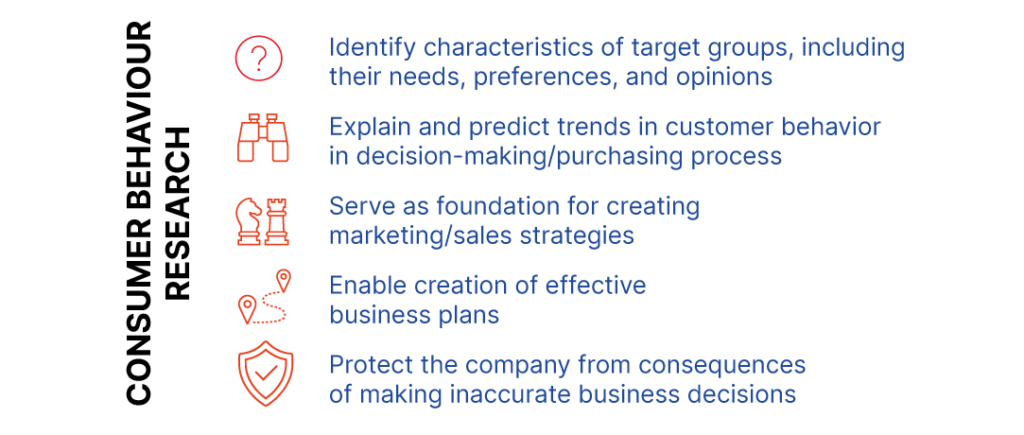
Why is consumer behaviour research so important?
In the rapidly changing world, equally fast changes the consumer behaviour. Their rising awareness, access to other opinions, growing popularity of online shopping prompts monitoring of current shopping trends. A well implemented consumer behaviour research project is of the utmost importance for company’s financial results. On one hand, it supports effective business decision making, on the other hand, such research prevents from making unfavourable decisions, such as bad investment in advertising or inadequate product packaging.
The importance of marketing research has significantly grown, as marketers, marketing department managers and brand managers, constantly face various challenges and must make decisions about increasing product sales. These decisions might concern the changes in the product itself (taste, ingredients etc.), but they also involve the changes in product description, packaging, name, unusual forms of promotional activities, new commercials, pricing etc.

All these actions can potentially be successful, but also, they might result in a failure. Market research is carried out to increase the chances of success (and minimise the risk of failure).
The knowledge on consumer preferences acquired during marketing research gains particular importance in a situation when market is saturated with products of very similar properties. Then this knowledge becomes essential for tailoring products, services and marketing communication to consumer expectations in order to gain competitive advantage. Hence marketing research is a very important element of product managing process and the experience gathered around the world shows that adequate marketing research might contribute to successful business.
What kind of information does consumer behaviour research deliver?

Consumer behaviour research delivers information about consumer needs and preferences. It provides knowledge about society, demographics, culture and psychology, which have an impact on business decisions. Thanks to this information, we can make efficient business decisions, implement them, carry out promotional activities and successfully sell our products.
What are consumer behaviour trends?
Trend is a process of long-term or short-term sociological, psychological or economic changes, on global or regional level. Environmental factors of economic, legal, political or demographic nature have impact on consumer behaviour.
Considering the development level and the speed of change, we can observe both fading trends, stemming from crises or, trends in progress, pointing out to the future.
The research verifies, which trends in specific areas will intensify, which will fade, and what emerging trends might occur.

What factors influence consumer behaviour?

Consumer shopping behaviour are shaped by four categories of drivers. While most of them remains out of our control, we should still factor them in:
cultural drivers – culture and society the consumer lives in
social drivers – social groups, status and roles
personal drivers – age, profession, living conditions, lifestyle, hobbies
psychological factors – motivation, perception, education, opinions and views
When it comes to finalising the shopping process, other factors, related to place – such as sales point or online shop – comes into play. We should not forget about influence techniques, used by the provider, such as commercials, shop arrangement or exposition.
What is consumer perception?
Perception is one of the basic processes by which humans learn about their environment. In this process, objects are perceived, as an effect of environmental stimuli and data interpretation by sense organs. Some of them are below the threshold of conscious perception (subliminal stimuli) and some of them are out of attention span (peripheral stimuli). This can affect consumer behaviour and decisions.

Stimulus categorising is an important element of the process of perception, as it eliminates the effort put into thinking about the stimuli characteristics and matching them with previous stimuli, in terms of colour, shape of packaging, font etc. The font of labels often carries the information related to the product brand and category. Thanks to that the consumer can categorise the product immediately, for example classify it as a luxury cosmetic, even if the brand is unknown.
What techniques do we apply to consumer behaviour research?
We use the following techniques in our consumer behaviour research projects:
CATI
Telephone interview
CAWI
Online survey
PAPI
Pen and paper survey
Face to face FGI
Group interviews
FGI on-line
Group interviews
Ethnography
Observation and description
IDI
Individual face to face in-depth interviews
ITI
Individual online in-depth interviews
CAPI
Computer-Assisted Personal Interviews
Dyads, tryads
Small group interviews
User tests
Product tests, consumer’s assessment
DR
Desk research, secondary data analysis
MOBI
Face-to-face survey on mobile devices
Eye tracking
Biometric research – tracking the eye movement
Face tracking
Biometric research – facial expression analysis
Mystery e-mailing
Mystery shopper – testing customer service via email
Mystery calling
Mystery shopper – testing customer service via phone
Mystery shopping
Mystery shopper – testing face-to-face customer service
Project design methods
Design thinking, iterative design
Motion tracking
Motion capture - XSENS, Vicon, Kinect
Auditorium questionnaire
A questionnaire filled in by a specific group being in the same room
EMG
Biometric research – analysis of micro expression of facial muscles
EEG
Biometric research – brain activity analysis
GSR
Biometric research – the galvanic skin response
So far, we have had the opportunity to work with organisations, whose goal was to learn about their customers, their opinion, motivation and buying decision process. The research we conducted aimed to support in further implementation of plans and gaining new clients.
Why choose our offer?

For over 25 years, we have been carrying out marketing research. Owing to the highest quality standards, professionalism and acquired experience, we take great pride in high indicator of returning clients.
Furthermore, we constantly gain new satisfied client, who benefit from our research.
As we are experts in this field, the companies who work with us achieve better results.
We will be happy to answer your questions and suggest research methods most suitable for each individual case. We kindly invite you to get familiar with our full offer.
Consumer behaviour research – Price list
The consumer behaviour research, which we carry out, is customised and tailored to each client’s needs. Therefore, we strongly recommend contacting us, in order to obtain a detailed price list.
FAQ
Consumer behaviour research is a process aimed at learning about preferences, opinions and purchase decision making of selected groups of clients and defining their characteristics.
There is a wide variety of drivers of consumer behaviour, such as social (family), psychological (perception, motivation, preferences, emotions, opinions and values), geographical (place of living), personal (age, lifestyle, profession).
Due to the variety of researched factors, the schedule is discussed individually with each client. We can only indicate usual schedule, which is usually 5-6 weeks. This can be shortened or extended, depending on selected research methods and planned research scope.
The goal of neuromarketing is to deliver information on brain processes occurring during the consumer decision processes. This information enables creating successful marketing messages, which will encourage purchasing decisions and create brand loyalty.
Consumer behaviour research should be the foundation for each business, in order to determine the target groups for our products or services. This research is useful for anyone who wants to gain market recognition, achieve success, increase sales, launch a new product appreciated by consumers, or wants to gain competitive advantage.
We use quantitative, qualitative, neuromarketing and biometrics in consumer research.
- CAWI – data collection method used in quantitative market and opinion research, which relies on computer-administered surveys.
- Biometric research – eyetracking, EEG, facetracking, GSR, EMG
- Mystery Shopping
- IDI – In depth interview
- CAPI, CAPI, MOBI – face to face interviews
- Auditorium questionnaire
We support all the industries






